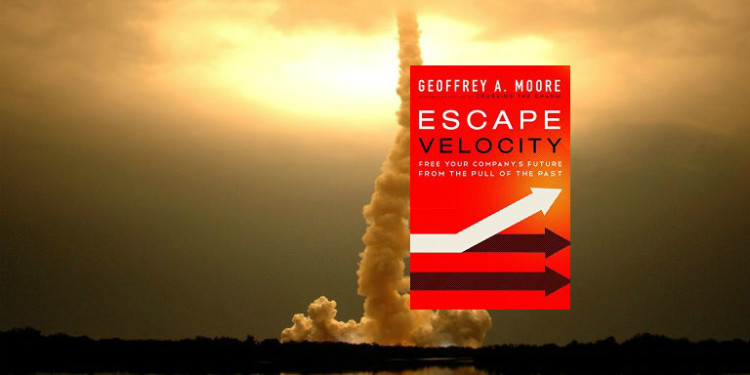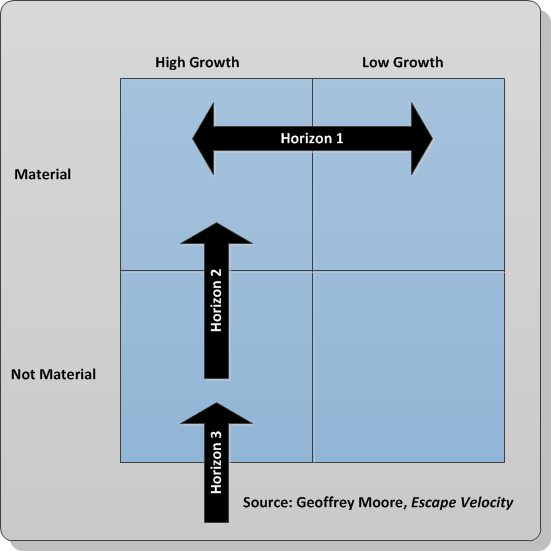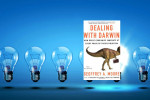Reaching Escape Velocity

Escape Velocity: Free Your Company’s Future from the Pull of the Past by Geoffrey Moore
In Escape Velocity Geoffrey Moore tackles the problem of breaking away from past business practices and market constraints to achieve growth. The fundamental structure within the book is the Hierarchy of Powers, a set of corporate attributes that defines how successful a company can be in its pursuit of profit and customers.
Moore diagnoses the root cause of this problem as the tendency for companies to use their prior year’s operating plan as the basis for next year’s business plan, only to find that they are unable break free of its gravity, constraints, and assumptions. Moore provides strategies for decoupling from previous plans and strategies which create the inertia that blocks future changes. He explains the differences between various strategies and approaches that help orient a company on the core (differentiation) and context (everything else) spectrum so that it can effectively fund the core for breaking free of the gravity of last year’s operating plan. He stresses the need for asymmetrical bets (i.e., being OK with risk and “burning the boats”) rather than peanut-buttering budget across all initiatives.
In Escape Velocity, Moore weaves together several models from his previous books. The Technology Adoption Lifecycle from Crossing the Chasm is used to orient a company within a market category (i.e., where along the lifecycle is the category?). Volume Operations and Complex Systems business architectures from Dealing with Darwin are the basis for execution strategies to achieve your goals. The Innovation Types from Dealing with Darwin used as “playbooks” for innovation efforts: differentiation, neutralization, and optimization.
Frameworks are not machines; they are a vocabulary. They do not produce strategies; they enable strategic dialogues.
The hierarchy of powers
The Hierarchy of Powers introduced in this book as a “framework of frameworks” consists of Category Power (managing the portfolio of market categories in which a company is involved), Company Power (your status relative to competitors), Market Power (market share in your target segments), Offer Power (differentiation of your offering), and Execution Power (your ability to drive strategic transformation within your enterprise). Once all the powers are aligned, you can achieve escape velocity. The five powers are modeled after the standard investment process: which category?, which market?, which company?, how competitive is the offer?, how effective is the company at execution?
Category power
Category Power is the starting point of Moore’s framework and culminates in a growth/materiality matrix that support prioritizing three types of efforts: Horizon 1, 2, and 3. Horizon 1 are current businesses which generate today’s cash flow, Horizon 2 are high growth businesses which generate revenue today and will generate cash flow tomorrow, and Horizon 3 are higher risk, options on future growth businesses. Moore discussed how these three business types interact in strategic planning and resource allocation processes. His primary point is that each type of business requires a different type of management style and support structure and that achieving “escape velocity” with Horizon 2 or 3 businesses requires a different approach than is used in Horizon 1 businesses.
Company power
Company Power is evaluated by three attributes: your competitive set, your core differentiation, and your execution strategy. As most authors, Moore focuses on differentiation and specifying your competitive set very precisely.
Market power
Market Power equates to a set of nine strategies for achieving effective target market initiatives. Moore provides a detailed set of recommendations on how to go about winning a specific target market segment. He focuses on markets that are in transition, and thus most likely to be in a secular growth (not to be repeated) phase rather than a cyclical growth (repeated) phase. Due to their disruptive nature, secular growth events are where Moore sees the biggest opportunity for leaving one’s competitive set behind.
Offer power
Offer Power relies on the type of innovation initiative you are pursuing. Moore brings the innovation playbooks from Dealing with Darwin to put into context current, future, and past projects. Productivity initiatives essentially optimize existing processes, while neutralization is intended to achieve competitive parity, and differentiation is meant to produce separation from your competitive set.
Execution Power
Execution Power is based on the two business architectures: Volume Operations and Complex Systems. Volume Operations businesses create products, deploy through a partner ecosystem, and optimize through business process refinement. Complex Systems businesses deliver value through projects, deploy to the market through customizable “playbooks” and eventually optimize with standard products. Moore outlines how to be successful with both of these “arcs of execution”.
Reach your escape velocity
In this video Half way through the video, Moore pauses for student questions. One student asks him whether he has any empirical evidence to support his framework, to which he replies that it is mostly qualitative; another student asks whether the framework actually explains Apple’s success. Moore acknowledges that it cannot fully explain why Apple is so wildly successful and that many frameworks could be applied to Apple. In the latter part of the video, he covers the three Return on Innovation playbooks and stresses the need to assign only one of the three goals to any given innovation project. He says: “One playbook per project!”Overview of Escape Velocity by Geoffrey Moore
Leave a reply









